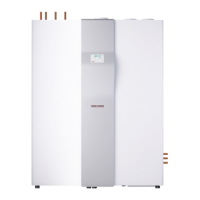10
SETTINGS
HEATING
Two heating circuits can be operated with this appliance, e.g. one
direct heating circuit for radiator heating system and one heating
circuit with mixer for underfloor heating system.
Enter the „ROOM TEMPERATURES HC1“ submenu for settings ap-
plicable to the first heating circuit.
ROOM TEMPERATURES HC1
ROOM TEMPERATURE DAY HC1
ROOM TEMP. NIGHT HC1
ROOM TEMP. STANDBY HC1
MANUAL SET HC1
ROOM TEMPERATURE HC1
Select the required set room temperature for day, setback and
standby modes.
MANUAL SET HC : Under this parameter, set the heating flow tem-
perature for manual mode.
ROOM TEMPERATURE : This parameter, the display of the current
value, is only shown if a room temperature sensor is connected.
ROOM TEMPERATURES HC2
See chapter „ROOM TEMPERATURES HC1“. Set the values in this
submenu accordingly.
HEATING CURVE HC1
GRADIENT HC1
LOW END HC1
ROOM INFLUENCE HC1
FLOW PROPORTION HC1
MAX. SET VALUE HC1
MIN. SET VALUE HC1
HEATING CURVE HC1
The room temperature will only remain constant irrespective of
the outside temperature if the correct heating curve has been
selected for the relevant type of building. Selecting the correct
heating curve is therefore vitally important. The more precisely
the heating curve is set, the more economically the appliance
works. Try therefore to optimise your heating curve. Reduce the
current heating curve until the flow temperature is just sufficient
for heating. The target is as flat a heating curve as possible.
Fully open thermostatic valves (remove head) in a lead room,
for example living room or bathroom.
At different outside temperatures, adjust the heating curve so
the required temperature is set in the lead room (living room
or bathroom). Now the room temperature in these rooms is
controlled with the heating curve (see next diagram).
Standard values to begin with:
GRADIENT 0.4 0.8
LOW END K 3 10
ROOM TEMPERATURE DAY °C 20 20
1
3
2
4
5
∆Y
∆X
D0000051930
X Outside temperature [°C]
Y Heating circuit temperature sensor [°C]
1 Gradient influence
Gradient = ΔY/ΔX
= Heating circuit temperature change/Outside temperature
change
2 Low end offset influence
3 Heating curve
4 Set room temperature influence
5 Low end
GRADIENT
With the „GRADIENT“ parameter, you can set the extent to which
a change in the outside temperature causes a rise in the flow tem-
perature. Typical problem: Increase the gradient if the room tem-
perature is too low at low outside temperatures (approx. -10°C).
LOW END
By changing the „LOW END“ parameter, you cause a parallel offset
of the heating curve. Typical applications are explained in the
chapter „Troubleshooting“.
ROOM INFLUENCE
If you want to influence the heating curve through the room tem-
perature, install an auxiliary „FESComfort“ programming unit in
your home. As the underfloor heating system has a delayed effect
on the room temperature, this can be counteracted via additional
heating such as solar irradiation or a fireplace. You must enter a
value > 0 for the „ROOM INFLUENCE“ parameter.
Set heating circuit temperature= set heating circuit temperature
from heating curve+ ((set room temperature- actual room tem-
perature)* room influence* gradient/ 10)

